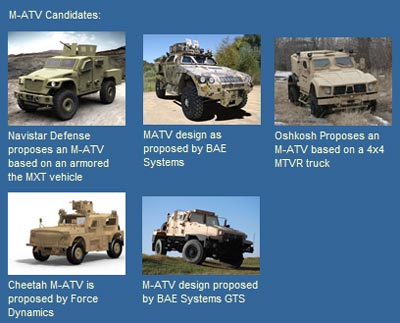The Pentagon plans to evaluate up to five MRAP All-Terrain Vehicle (MRAP-ATV) candidates, awarding a single prime contractor production orders for up to 10,000 such vehicles. The Army plans to award an initial an order for 2,080 vehicles by May 2009, to be produced at a minimum rate of 100 vehicles per month. Contractors are required to have the capability to ramp up production to 1,000 vehicles per month, in response to urgent demands from the field. To ensure accelerated delivery, the government will weigh production capability and deliverability more than price, when evaluating the competing proposals, supporting the accelerated program schedule. First unit fielding is planned for the fall of this year.
The Army’s Tank & Automotive Command (TACOM) awarded five US $5 million contracts to four bidders. Oshkosh, Force Dynamics, BAE Systems (two bids were accepted) and Navistar submitted proposals and received orders for immediate delivery of two vehicles each.
According to the original schedule the Army could begin down selecting by mid- April but eventually elevated all five candidates for the final selection, awarding orders for three production representative vehicles to each of the companies: BAE Systems (x2), Navistar, Force Dynamics and Oshkosh. These vehicles will continue mobility and protection evaluations through May 2009. Final selection (preferrably of a single contractor) and Initial production orders are expected by early June with serial deliveries to follow within three months.
Similar to MRAP, M-ATV will be conducted under approved ‘DX ratings’, and an Urgent Material Release (UMR), representing the highest priority acquisition approved by the Secretary of Defense or Deputy Secretary of Defense, presenting manufacturers with an attractive commercial opportunity but also great logistical and contractual challenges. The manufacturers are also expected to closely support the vehicles in the field for several years, as the Pentagon assumes that organic logistical support could not be fielded until the third year after initial production deliveries.
The Army is trying to avoid the pitfalls encountered by the Marine Corps in the MRAP program, by issuing a single order to one prime contractor. In 2007, after being ‘dragged’ into the MRAP program, the Marine Corps under pressure from the field, the Pentagon and the public, issued production orders of different vehicle versions to multiple contractors, to meet the urgent delivery schedules. The resulting effects are felt currently, with the costly field support for the different versions. “Going to multiple companies for the same capability generates extensive logistics cost. We are very serious about not generating that situation with the M-ATV and having the successful contractor from day one having a viable, valid, properly supported plan to get to the larger quantities that may be needed”, a program official commented, recommending several ways to address production ramp-up issues – including licensing multiple production sites, splitting out portions of the work, duplicating a second plant, production line, increasing work shifts. “There is currently extensive unused capacity in the automotive industry and it is even possible that resource may be tapped into to address this potential need.”
- M-ATV Specifications and Performance
- Implementing Lessons from the MRAP
- M-ATV Candidates
- Producing the M-ATV
- BAE Unveils Two M-ATV Models
- Cheetah M-ATV Candidate
- Oshkosh Unveils MTVR-Based M-ATV
- Navistar’s proposes MXT for M-ATV




















